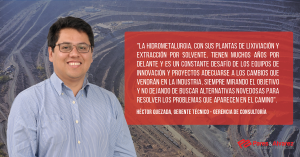
Hector Quezada
Consultancy Management
21 April 2022
It is already known that the appearance of new materials and the efforts of companies such as Antofagasta Minerals, BHP or Minera Tres Valles, have made the leaching of secondary sulphides in a chloride environment an efficient and beneficial practice for the mining companies that have opted for this option to extend the useful life of the ore.
On the other hand, in the coming years, a number of projects are expected to be completed to leach primary sulphides, a process that is more demanding and requires higher operating temperatures, which poses a great challenge to the companies’ innovation teams.
Likewise, in the engineering world, every day the emergence of new technologies redefines the limits of what is possible, and forces us to challenge the pre-established. The work of rethinking how we do things requires changes in the ways we approach problems, and looking to the experience of other industries is an option that cannot be ignored.
Currently, thinking about transforming heap designs that were conceived to leach oxides is a challenge for teams developing projects to transform their processes. There will always be the temptation to crush finer to achieve higher recovery. However, this has to be reconciled with what existing plants can actually achieve, a review of the energy cost of size reduction and the limitations of the ore in terms of the stack heights that can be achieved. This last parameter also affects the fact that at higher heights, which are achieved with coarser particle sizes, the exposed area is reduced, less heat is lost to the environment, so the cost of insulating the systems is reduced and heat conservation becomes more efficient, thus reducing the energy cost. In this way, there are a number of factors that must be taken into account to find the right solution for a project that maximises the benefits.
Another point to take into account is the space available for the new facilities required. In general, plant designs were designed to optimise the distances travelled by the solutions and compact designs do not leave sufficient space for new installations in the vicinity of the stack. This generates a series of limitations when thinking about technologies to achieve the heating of solutions, where alternatives such as the use of solar thermal panels, with a large surface area demand and which are very attractive to achieve the companies’ decarbonisation commitments and have made great advances in terms of technology in recent years, must be studied with an open mind.
Problems such as the handling of corrosive solutions and drag control require, for example, the adaptation of technological solutions from other industries such as lithium or oil, where several of these problems are solved at other scales. In the same way, continuous monitoring is needed for the incorporation and adaptation of new materials and equipment that the market is constantly generating.
Hydrometallurgy, with its leaching and solvent extraction plants, has many years ahead of it and it is a constant challenge for innovation and project teams to adapt to the changes that will come in the industry, always looking at the objective and not ceasing to seek novel alternatives to solve the problems that appear along the way.
